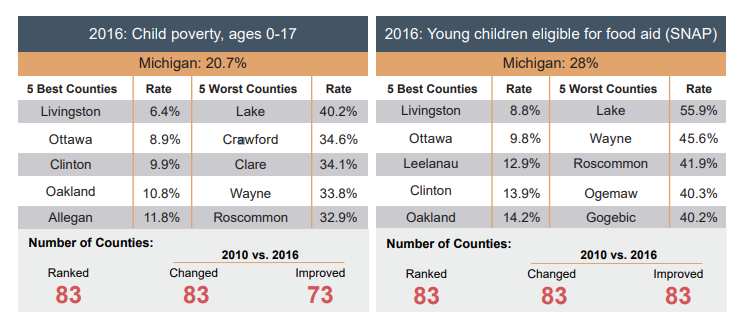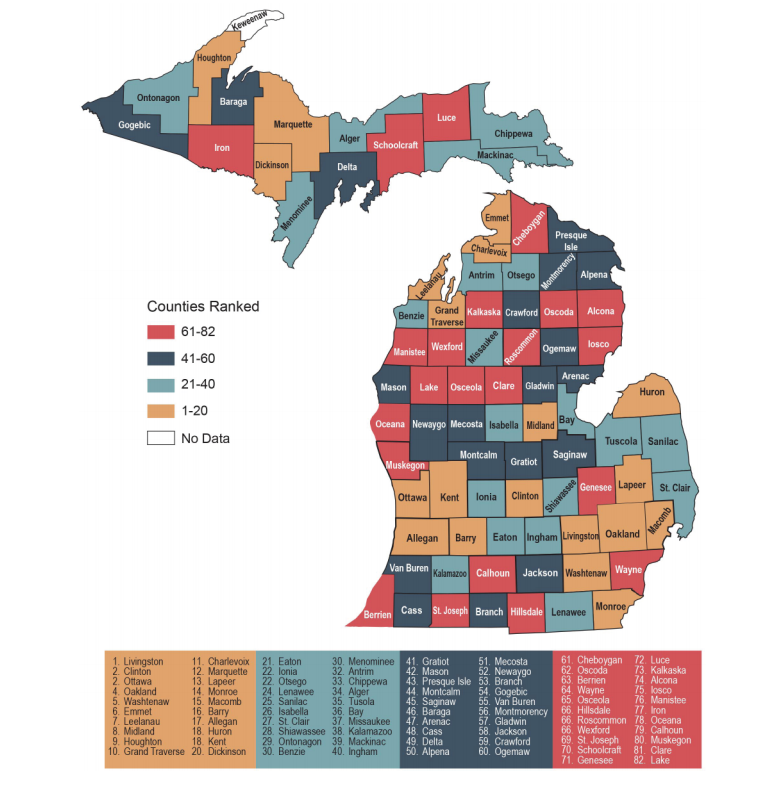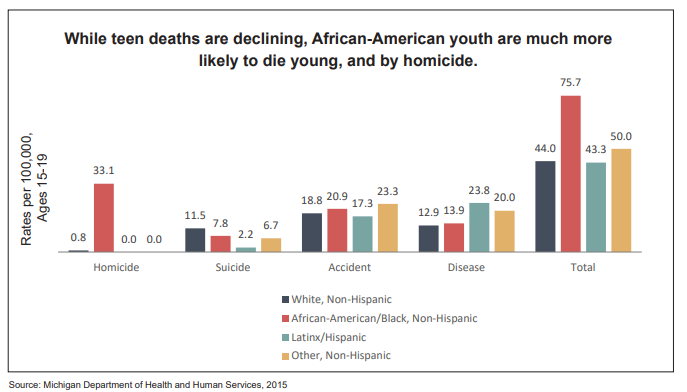DETROIT – Michigan's child poverty rate decreased to about 21 percent in 2016, but disparities among racial groups remain.
The annual Kids Count Profile released Tuesday by the Baltimore-based Annie E. Casey Foundation reports 444,100 of Michigan's children lived in poverty that year.
Recommended Videos
Related: Michigan has one of the largest populations of homeless students in US
Some other key findings were:
- Poverty rate of black children decreased from 47 percent in 2015 to 42 percent the following year, but remains the highest among racial groups.
- The 2016 rates for other groups were: 30 percent for Latino children, 26 percent for mixed-race children and 15 percent for white and for Asian children.
- 65 percent of Michigan's students weren't college-ready
2018 trends in child well-being in Michigan
Population:
- Total child population (ages 0-17) decreased 5.8 percent from 2010 to 2016.
- Total child population (ages 0-17) by race: Hispanic increased 4.1 percent, white decreased 6.4 percent, African-American decreases 6.7 percent, while "other" increase 12.4 percent.
- Michigan's overall population (all ages) decreased 0.8 percent in time frame.
Economic Security:
- Children in poverty (ages 0-17) decreased 11.5 percent between 2010 and 2016.
- Young children (ages 0-5) on food assistance decreased 24.8 percent.
- Students receiving free/reduced lunch saw no change, staying at 45.8 percent.
Health:
- Rate of less than adequate prenatal care increased 9.5 percent on average between 2008-2010 and 2013-2015.
- Infant mortality rate decreased by 6 percent.
- Child/Teen deaths (ages 1-19) dropped 8.7 percent.
- Infant death rate rising for Hispanics, more than double for African Americans compared to Whites.
Family and Community:
- Births to teens (ages 15-19) dropped 33 percent from 2008-10 to 2013-15.
- Child abuse/neglect:
- Children in investigated families increased 60 percent from 2010 to 2016.
- Confirmed victims increased nearly 30 percent.
- Children in out-of-home care decreased nearly 7 percent.
Education:
- 3 and 4 year-olds not in preschool dropped 0.5 percent between 2008-10 and 2013-15.
- Students not graduation on time dropped 15.4 percent between 2010 and 2016.
- Students not college ready stayed at 65.1 percent.
Overall child well-being in Michigan, ranked
According to the report, Michigan's bottom-ranked counties for child well-being are:
- Lake
- Clare
- Muskegon
- Calhoun
- Oceana
The top five are:
- Livingston
- Ottawa
- Clinton
- Oakland
- Washtenaw
Other notable Michigan county rankings (out of 82 total):
- No. 10: Grand Traverse
- No. 13: Lapeer
- No. 14: Monroe
- No. 15: Macomb
- No. 18: Kent
- No. 24: Lenawee
- No. 27: St. Clair
- No. 36: Bay
- No. 38: Kalamazoo
- No. 40: Ingham
- No. 45: Saginaw
- No. 58: Jackson
- No. 64: Wayne
- No. 71: Genessee
Check out the full rankings map below:
Child population in Michigan
From 2010 to 2016, Michigan's total population of children decreased 5.8 percent, from 2,344,068 to 2,207,304.
Related: Report details hardest hit Michigan areas for opioid use, drug overdoses
More than 1 in 4 Michiganders are kids under the age of 18. Almost 1 in 3 kids are children of color.
Economic security of children in Michigan
The report found that the federal poverty level does not adequately capture all struggling families.
- More than 2 in 5 (42 percent) children lived in families at 200 percent of the federal poverty level, or $48,678 (two adults working a combined wage of $23.40/hour) for a family of four.
- Almost one-third (32%) of children lived in families at 150% of the federal poverty level, or $36,509 (two adults working a combined wage of $17.55/hour) for a family of four.
- Around 1 in 10 (9%) children lived in families at 50% of the federal poverty level, or $12,170 (two adults working a combined wage of $5.85/hour) for a family of four.
Younger children are more likely to be living in poverty in Michigan. 23 percent of children under the age of six are in poverty, while 19 percent between six and 17 years-old are in poverty.
What does this mean for kids in Michigan?
According to the report, more than 1 in 5 kids in Michigan live in poverty while 2 in 5 live in a family struggling to make ends meet. Despite the state’s economic recovery, parents are challenged with finding secure employment: 31 percent of kids live in families without year-round, full-time employment, and it’s higher for African-American (54 percent) and Latino (39 percent) children.
The lack of resources can lead to food insecurity, homelessness and neglect in child welfare, all of which have long-term effects on child and adult well-being. In neighborhoods with high levels of poverty, it becomes even more difficult for families to access needed support—regardless of whether a family itself lives in poverty.
Government safety net programs and other policies that support work, like the federal and state Earned Income Tax Credit (EITC), are critical for families. The supplemental poverty measure shows the importance of these programs; child poverty is reduced to 15 percent when we account for many government programs. Unfortunately, many of these have been eliminated or severely reduced.
Other notable findings from the Kid Count in Michigan report:
While teen deaths are declining, the report shows African-American youth are much more likely to die young - and by homicide.
Kids of color are more likely to attend under-resourced schools compared to their white peers, resulting in disparate outcomes in third-grade reading.
Third-grade reading differs significantly by family income: 71 percent of students from families with low incomes are not proficient compared to 40 percent of those in families with higher incomes.
Students of color face additional barriers to reaching college readiness.








